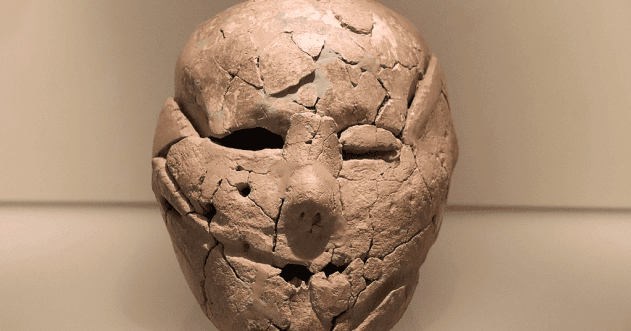Humans have always had a special way of remembering those who’ve passed. Instead of simply saying goodbye, many cultures throughout history have chosen to honor their dead with elaborate rituals and, sometimes, by turning their very remains into art. It might sound a bit unusual to us today, but this practice reveals so much about how our ancestors viewed life, death, and the afterlife. Get ready to explore ten incredible examples where human remains were given an extraordinary, and often beautiful, makeover.
1. For the Love of God
Art often makes us think, and sometimes it can be a bit shocking. Artist Damien Hirst took this to a new level with his piece, For the Love of God. This isn’t just any sculpture; it’s a real 18th-century human skull transformed into a dazzling work of art. Hirst had the original teeth cleaned and then cast the skull in platinum. This platinum base was then encrusted with an incredible 8,601 flawless diamonds. A large pink diamond sits right on the forehead, making it even more striking. Finally, the skull’s original teeth were put back into the platinum jaw. This sparkling, grinning piece was offered for sale at a jaw-dropping £50 million, making us question art, value, and mortality all at once.
2. Tezcatlipoca Turquoise Skull
Long before modern artists embellished skulls, ancient cultures were creating their own masterpieces. The Tezcatlipoca Turquoise Skull, housed in the British Museum, is a stunning example from the Aztec civilization, dating back to the 15th century. This human skull is meticulously covered with small tiles of vibrant turquoise, dark lignite, and shimmering seashells. Its eyes, made from polished pyrite, seem to stare right through you. Interestingly, the back of the skull was cut away, and the inside lined with deerskin. The jaw is even loosely attached, allowing it to move! It’s believed this skull represents Tezcatlipoca, an important god linked to things like night, conflict, and magic. Straps, once painted red, suggest it was designed to be worn, perhaps by a priest during important ceremonies. Studies of similar Aztec decorated skulls suggest they were made from the remains of very high-ranking individuals who were sacrificed.
3. Gobekli Skulls
Travel back even further in time to Gobekli Tepe in Turkey, one of the world’s most mysterious ancient sites. Dating from around 8000 to 9000 BC, it features some of the oldest known large carved stones, adorned with animals and patterns. Alongside animal remains, possibly from sacrifices, archaeologists found human remains that hint at what some call a “skull cult.” Some human skulls discovered here have clearly intentional carved marks on them. It seems that after the flesh was removed, deep cuts and holes were made in the bones for a specific, unknown ritual purpose. The deliberate nature of these marks, along with traces of ochre pigment dabbed onto the bones, strengthens the idea of a ritual. These Gobekli skulls might just be the earliest examples of decorated human remains ever found, offering a glimpse into very ancient beliefs about death.
4. Monk in a Statue
Imagine buying an old statue and finding a hidden secret inside. That’s exactly what happened when a Chinese statue of a Buddhist monk, bought at a market in the Netherlands, was taken for restoration. To everyone’s surprise, it contained a human skeleton! In 2014, a CT scan revealed the incredible story. Inside the statue was the 1,000-year-old body of a Buddhist master named Liuquan, who died around 1100 AD. He was preserved in a seated position that perfectly matched the statue’s form. Further investigation, using probes, found that the monk’s internal organs had been removed. In their place, scraps of paper with Chinese writing were carefully inserted before the body was encased in the gold-painted statue, effectively turning him into his own memorial.
5. Kapala Skulls
In Tibetan Buddhism, the term Kapala refers to a cup or bowl, often made from a human skull. This practice is linked to “sky burials,” where the deceased were left in nature for birds and animals to consume the flesh. Once only bones remained, the skull could be retrieved and transformed. These Kapala skulls weren’t just left plain; they were ritually anointed with oils and carefully prepared for use in sacred ceremonies. Many were beautifully decorated by carving intricate patterns directly into the bone or adorning them with silver and precious stones. Kapalas could be placed on altars or even used as bowls for drinking or eating. It was believed that by consuming from the skull, one could absorb the wisdom and knowledge of the person it once belonged to. They were also used in offerings to appease powerful deities, sometimes filled with cakes shaped like human body parts.
6. Bad Durrenberg Shaman
Today, we often dress the deceased in their best clothes for burial. Thousands of years ago, people were sometimes buried with items representing their role in life. In Bad Durrenberg, Germany, around 9,000 years ago, a woman was buried in an outfit that strongly suggests she was a shaman, a spiritual leader. Known as the Bad Durrenberg Shaman, this woman, aged about 25 to 30, was found buried in an upright sitting position, packed in thick red clay. A young baby was buried near her. What makes her burial truly special is her attire—her regalia. This included a stunning headdress made from various animal bones, teeth, and even two horns from a roebuck deer. Studies suggest she had a neck malformation that might have restricted blood flow, possibly causing her to faint if she held her head in certain ways. This could have been interpreted as an ability to connect with the spirit world, making her a vital link for her community.
7. Dressing the Dead in Sulawesi
On Sulawesi Island in Indonesia, a remarkable festival called Manene takes place. It’s an event where everyone is expected to join in – the young, the old, and even the dead. During Manene, families gather to clean the tombs of their ancestors. Then, they carefully take the bodies of their loved ones out into the sunshine. Once exhumed, the corpses are dressed in fresh, new clothes. This ritual is a way for the living to show continued respect and love for the departed. Some are even given their favorite things to emphasize how much they are still cherished; a pair of sunglasses to shield their eyes, or perhaps a cigarette. The community believes that by treating their deceased ancestors with such respect, the ancestors will, in turn, bless the living. The Manene ceremony is performed every few years, and many of the bodies are surprisingly well-preserved, suggesting they are resting peacefully.
8. The Oldest City’s Painted Dead (Çatalhöyük)
Çatalhöyük, located in modern-day Turkey, is considered one of the earliest urban-like settlements, a sort of proto-city. Inhabited from around 7100 to 5600 BC, its structure was very different from cities today. The mud-brick houses were built right next to each other, with no streets or paths between them. People entered their homes by walking across the rooftops and climbing down a ladder. While how people lived is fascinating, how they treated their dead is equally intriguing. Many homes had bodies buried beneath their floors. The exact reason for this practice isn’t known, but what makes the Çatalhöyük burials stand out is that some of the deceased were ritually painted after death. Archaeologists have found bodies with striking red cinnabar pigment applied to them. For example, one skull shows a clear stripe of this pigment. Only some of the bodies found were painted this way, raising questions about who received this treatment and what it signified.
9. Jeweled Saints
In the Catholic faith, there’s a long-standing tradition of revering the body parts of saints as holy relics. These relics were often believed to grant miracles to those who prayed before them. A lesser-known fact is that even today, all Catholic altars used for Mass contain small relics. While some relics are hidden, others are put on grand, ostentatious display. When people think of reliquaries, they might picture a small, ornate golden box holding a saint’s finger or a piece of bone. However, sometimes the entire skeleton of a saint is turned into a sparkling, bejeweled relic. For instance, Saint Deodatus in Rheinau, Switzerland, is displayed sitting upright, dressed in shining armor, with his skull covered by a wax mask. Other traditions prefer to display only the skull. These so-called “catacomb saints” were mostly sent from Rome to churches across Europe. The churches that received these remains often spent fortunes coating the bones in gold or silver and studding them with precious gems, creating dazzling displays of faith and remembrance.
10. The Jericho Skull
Around 9,500 years ago in Jericho, now part of Palestine, a man passed away. We know about him because his skull was unearthed by archaeologists in 1953. This isn’t just any ancient skull; it’s special because we have an idea of what this man looked like. After his death, his head was separated from his body. A hole was cut into the back of the skull, which was then filled with soil and sealed with clay. The most remarkable part is that the skull was then covered in plaster, which was carefully molded to recreate the man’s facial features. Shells were inserted into the eye sockets to make them look like real eyes. This incredible artifact is thought to be the oldest portrait in the British Museum’s collection. Scans later confirmed that the plastered face was indeed intended as a likeness of the individual. They also revealed that the man’s head had been bound during infancy, a practice that permanently changed its shape. Other plastered skulls similar to the Jericho Skull have been found, some using cowrie shells for eyes, offering a unique window into ancient ancestor veneration.
From dazzling diamond skulls to ancient plastered faces, the ways humans have decorated remains are truly diverse and deeply meaningful. These practices show us that death, for many cultures, wasn’t just an end but a transition often marked with art, reverence, and a desire to keep the memory of loved ones alive in extraordinary ways. Each decorated remain tells a unique story of belief, art, and the enduring human connection to those who came before us.
What do you think of these incredible traditions? Which decorated remain fascinated you the most? Leave your comment below and share your thoughts!










